There’s a reason more companies are linking their CRMs with social media management tools like Sprout Social: Optimizing your customer experience should be at the forefront of your social media strategy.
Through a global partnership with Salesforce launched in 2022, Sprout and Salesforce continue to usher in a new era of social customer care. The Sprout Social Salesforce integration empowers your brand to deliver world-class social customer care—all without interrupting your team’s workflow.
And, the Service Cloud integration ensures Salesforce customers can manage all of their social customer care requests directly from within Service Cloud. It enriches customer CRM profiles with social data to provide a holistic view of customer interactions–speeding up internal collaboration while uncovering valuable insights.
In this guide, we’ll break down exactly how the Sprout Social Salesforce integration works. We’ll also highlight how the integration streamlines tasks across your entire business and makes it easier to prove the effectiveness of your strategies.
Why you need to integrate your CRM with social media ASAP
The importance of social media integrations with your business’ tech stack can’t be overstated. And your CRM platform should be a top priority.
This is especially true as customers rely on social media as a research tool, support channel and place to sound off about brands.
According to the 2023 Sprout Social Index™, 76% of consumers notice and appreciate when companies prioritize customer support, and 70% of consumers expect a company to provide personalized responses to customer service needs. Yet only 30% of brands have adopted customer care processes and tools designed to actively engage with customers on social.
When brands leave their consumers behind, they’re missing out on key opportunities to improve customer retention and their bottom line.
The Sprout Social Salesforce integration addresses this.
Before we get into the nitty-gritty, let’s dive into some of the key upsides of linking your CRM with your social presence.
Create a 360-degree view of your customer
Social data is the missing puzzle piece that completes the 360-degree view of your customer.
According to the 2023 State of Social Media report, 88% of business leaders agree social media data and insights are critical to delivering exceptional customer care.

Empower your agents with a complete customer 360 view before responding to customers. Sprout Social enriches your Salesforce customer CRM data with social data to provide a comprehensive view. With this integration, agents can engage in real time with the right context.
Sprout’s Tableau Business Intelligence (BI) Connector takes it a step further by combining social data in an omnichannel view, customized with the exact visuals and metric combinations companies need. This delivers rich data options and visualizations that give users a complete view of their customers, without requiring time-consuming work.
With a more complete picture of your customer, you can create meaningful customer journeys and segment audiences based on their social interactions with your brand. Use the robust social data shared with Salesforce to ensure you’re delivering personalized messages that convert contacts to lifelong customers.
Monitor make-or-break moments in the buyer’s journey
CRMs help businesses assist leads and customers on the path to purchase.
And social media is where so many crucial moments happen during that journey.
This rings true for B2B and B2C alike. Let’s assume that the typical B2B buyer’s journey is around eight months. Social interactions are a given for folks doing their homework on a product.
Meanwhile, research from TikTok describes consumer behavior as an “infinite loop” in B2C. The modern path to purchase is far from linear when people are bouncing between so many channels.
As customers bounce between platforms and content, social media serves as a place to make valuable touchpoints along the way. This includes answering questions and publishing educational content to nurture leads.
In fact, the most recent Index found the primary reason people follow brands on social is to stay informed about products and services.
Earn (and track) more social sales
The growth of social selling speaks for itself.
Do activities such as customer care and content marketing contribute big-time to closing and retaining leads? Of course.
Still, they’re difficult to track without a CRM.
With integrations like those between Sprout Social and Salesforce, it’s so much easier to attribute sales from social. The ability to quickly answer questions and handoff cases between social, sales and support likewise makes it easier to respond to people quickly.
Gather meaningful customer insights you might otherwise miss
The more info you have about your customers, the better.
Consolidating touchpoints between social media and your CRM gives you a more in-depth understanding of your audience. And by tapping into Sprout’s Tableau BI Connector, your team can access all consumer data in one place to get a birds-eye view of how social media fits into the larger picture.
Fact: the 2023 State of Social Media report found that 95% of business leaders agree they must rely more heavily on social data to inform decisions outside of marketing. Consider how many people use social media as a place to sound off about brands.
These conversations and activities provide insights for sales and support, including:
- Sales objections
- Pain points and challenges
- Wants and needs
- Competitor advantages (and disadvantages)
With all of the above on hand, your team can approach leads and customers with a much-needed sense of confidence.
A powerful, all-in-one social media management platform

How does Salesforce integrate with Sprout Social?
Here’s a quick snapshot of the Sprout Social Salesforce integration and what you can do with it:
- Create Salesforce contacts, leads and cases directly in Sprout. This means you can route social customers to support and sales without leaving Sprout or Salesforce.
- Paint a complete picture of your CRM contacts with information and conversations via social media.
- Tie your social presence to actual business results with analytics and reporting.
- Personalize audience segments and journeys in Marketing Cloud based on your social data.
- Respond directly within Service Cloud where agents work, reducing the need for multiple tools wrapped in a layer of governance and security.
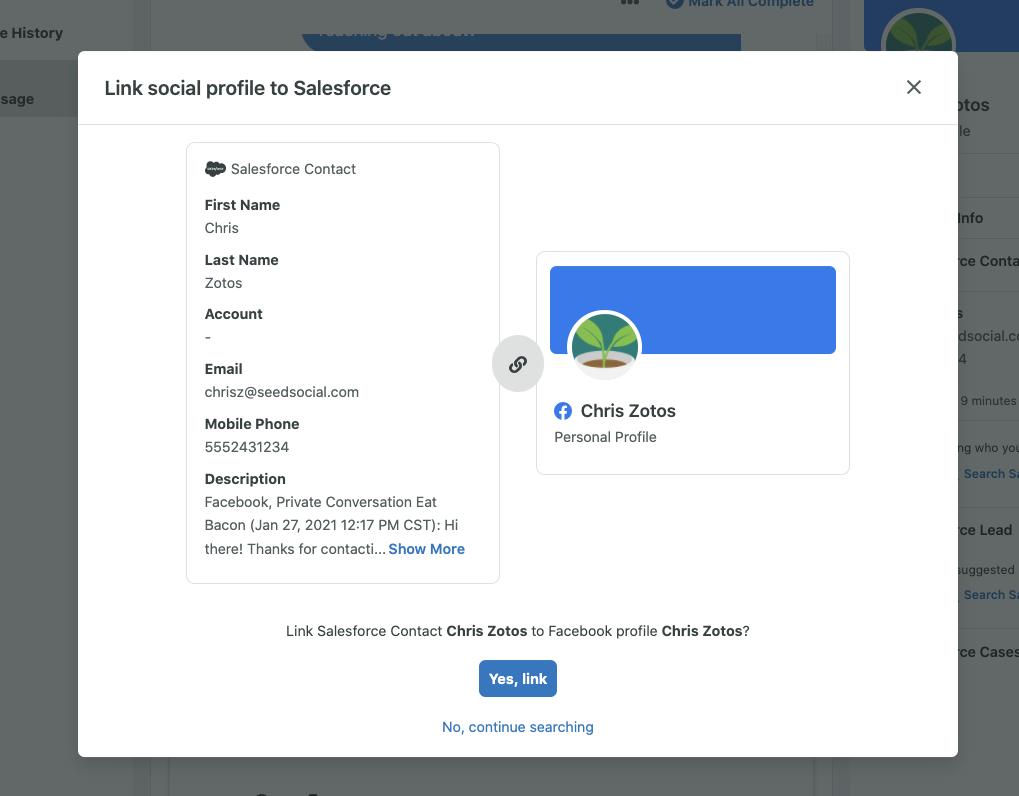

As an added bonus, our Salesforce integration is available on all Sprout plans. Features and requirements below:
- Requirements: Salesforce account
- Data types: messages, contacts, tickets
- Key functionality: create leads, edit contact information, create cases, edit cases, auto-sync
What entities are available with the Sprout Social Salesforce integration?
The Salesforce social media integration with Sprout Social allows the creation and editing of these entities directly within Sprout’s dashboard:
- Leads: Kick off the sales process by identifying potential customers through questions, comments and other social media interactions.
- Cases: Route customer issues or concerns posted on social to your support team without leaving the platform.
- Contacts: Beyond customers, you can keep track of social interactions with contacts such as company partners.
To learn more, check out this detailed breakdown.
Sprout + Tableau + Salesforce
We understand there are times when you need to take social data outside of Sprout to combine with other data streams (including customer care and other marketing data), and to further customize it based on your company’s own internal preferences.
With Sprout’s Tableau BI Connector, you can combine the power of social data with other business channels. The tool enables you to analyze data, create custom metrics and merge different data sources.

This seamless and customized view gives you a consolidated source of truth for wider business insights and performance.
The integration:
- Consolidates wider business updates
- Builds your perfect dashboard
- Accesses data without the dev network
For Salesforce users, this ensures social data and insights are included in your 360-degree view of your customers.
4 key benefits of using the Sprout Social Salesforce integration
To wrap things up, let’s look at some of the specific benefits of using a Salesforce social media integration like Sprout.
1. Provide better customer care
According to the Index, the most memorable brands on social respond to customers. And when consumers do reach out for help, 69% expect brands to respond within the same day.

Our Salesforce integration can help you keep tabs on every customer question that comes your way, and respond fast when you need to most.
Logging social activity means a more comprehensive understanding of your customers’ wants and needs. Not having to bounce between your CRM and social tools is a huge time-saver. In turn, you speed up your response time.
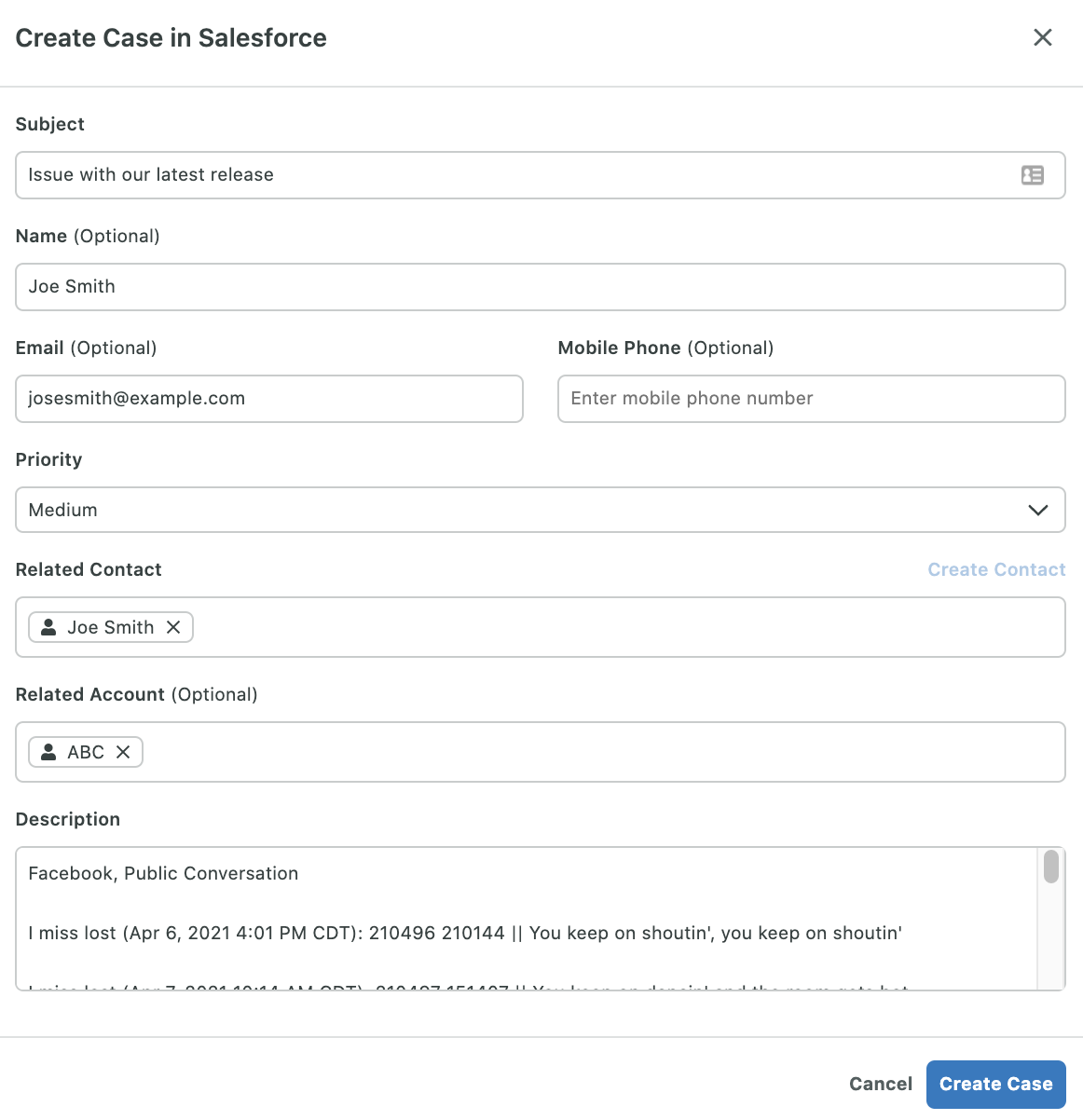
Not only that, our smart, automated case creation and routing feature improves agent productivity and optimizes the customer experience. It makes sure inbound messages reach the right agent fast—right inside of Salesforce. And because agents don’t have to spend time weeding through a never-ending stream of messages, they have more time to focus on high-quality customer care initiatives, leading to an improved customer experience.
The end result: responding to customers faster and coming up with better solutions to meet their needs. Doing so is a recipe for long-term loyalty and retention.
2. Align your marketing, sales and support teams
Consider that 36% of marketers say they struggle with cross-team collaboration.
When marketing, sales and support are aligned, each team is empowered to do their best work. There’s so much room for error if you only log your customers’ social interactions sometimes.
Think about it. If marketing or sales leave out key customer details in your CRM, your support team is left in the dark. On the flip side, marketing should be aware of sales objections and concerns to better speak to customers’ desires.
Here are some specific ways that Sprout’s Salesforce integration can help:
- Save time by eliminating needless back-and-forth between vendors, managers and social managers.
- Swiftly route cases to avoid bouncing between tools.
- Provide each team the context they need to serve your customers.

3. Boost the value behind your marketing content
Learning what makes customers bounce or stick around is invaluable for marketers.
Tracking these touchpoints can lead to the answers you need to create more impactful content, meaningful marketing messaging and personalized customer journeys. This includes:
- Blog posts
- Social posts (think: how-tos, tutorials and content you share to nurture customers)
- Reports, white papers and other lead magnets
- Webinars
For example, marketers might learn that high price points are the most common sales objection among lost leads. This information encourages the marketing side to reframe their messaging and how they speak to their audience.
4. More meaningful attribution via analytics
Perhaps most importantly, social integration with your CRM highlights the ROI of your team’s efforts.
This is an ongoing struggle for marketers, in particular. Although social media is a must-have for businesses, determining its business impact can be tricky.
That’s where Sprout comes in. Through our marketing and analytics features, brands can see how social engagements correspond with dollars and cents. Proving how these interactions contribute to revenue reinforces the value of social to stakeholders.

And with our reporting functionality in Salesforce, you can keep track of your full omnichannel experience, including seeing which channels (e.g. phone, email, social) and social channels (e.g. LinkedIn, Facebook) cases come from.

When you need to aggregate all of your marketing, customer care and social data in one place, Sprout’s Tableau integration will help you best tell the story of your brand’s success on social and beyond.
Checkout this article to understand why is Sprout the best alternative for Salesforce Social Studio.
Ready to try the Sprout Social Salesforce Integration?
From customer insights to better service, the upsides of linking your social presence with your CRM are crystal clear.
Thankfully, getting up and running with the Sprout Social Salesforce integration can be done sooner rather than later. Our platform makes it a breeze to beef up your tech stack while bringing your team closer together.
Request a demo of our Service Cloud integration or see how Salesforce themselves saved 12,000 hours in their first year using Sprout.
The post How the Sprout Social Salesforce integration strengthens your team appeared first on Sprout Social.
from Sprout Social https://ift.tt/RGrgJqp
via IFTTT








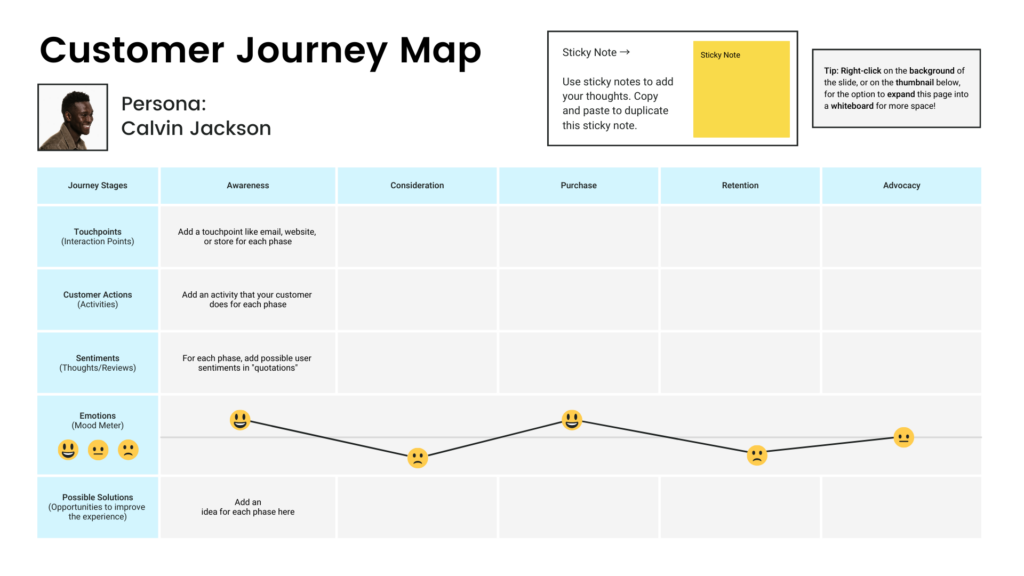

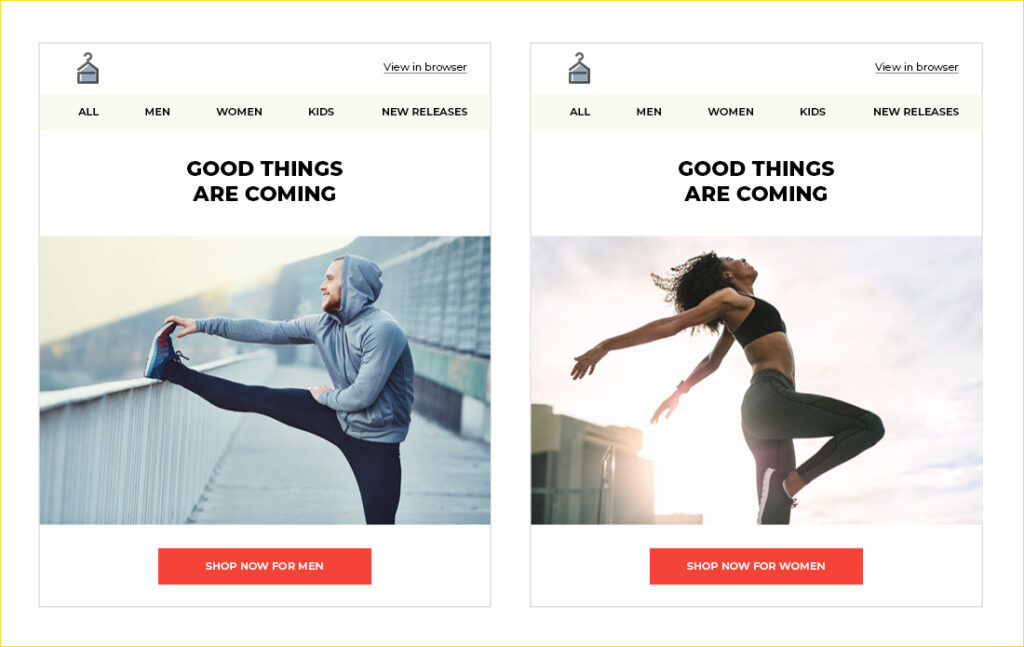
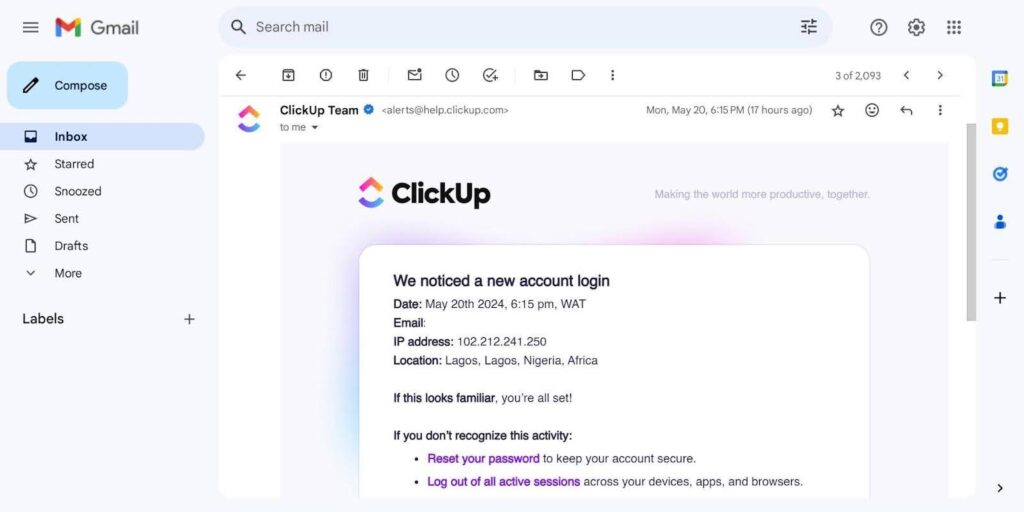





 8. Click-through rate (CTR)
8. Click-through rate (CTR)




